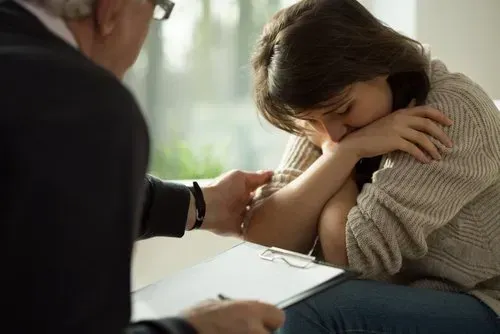Family Therapy in Lexington, Richmond & Frankfort KY
Many types of therapy are offered by our practice, including individual therapy, child therapy, psychiatric services, and more, our staff offers family therapy for many issues. Confidentiality and privacy are very important to our practice, and we maintain an environment in which you are safe and comfortable to explore your family issues. See the Counseling Process section of our website for further information on how you can start your journey. We have multiple locations to help easily accommodate you, and our well-trained staff can assist you with your particular needs.
You can view our professional staff here, give us a call now at 859-338-0466 or contact us today! We want to help and we care!
Following, please find some helpful explanations and resources for family therapy in order to decide if this might be right for you or your family.
Family therapy is a great opportunity to delve into familial issues, like when a family has a child in need of therapy, and the whole family desires assistance with coping and acceptance. Also, family therapy is appropriate for situations in which substance abuse or divorce might be present.
What is Family Therapy?
Family Therapy is used to address difficult situations and issues that arise in every family dynamic; sometimes families are faced with situations that are more than they can undertake on their own. Family therapy can assist with family issues relating to substance abuse, communication, dangerous behaviors like violence or abuse, and more. Partaking in family therapy sessions can help the family and individuals involved analyze, uncover, and address concerns they might have about moving forward. Goodtherapy.org has some great information on family counselors here.
Family Therapy can help alleviate many problems that might be interfering with communication among family members. Finding a good therapist to provide family therapy is the first step in mending your family. Family issues can become debilitating. They can sometimes interfere with the individuals’ well-being. Seeking therapy can help a struggling family overcome these issues and develop a successful plan to reestablish their family unit.
Also, to help understand, the family unit can be thought of in terms of a business. In order to have a functioning business, as a whole, each department must be functioning individually and together, in order to produce the effective whole. If one department is failing, the entire business will suffer, and if the entire business is not cohesive, the individual departments will face trouble. Psychcentral.com gives a great description of components of family therapy here. Family therapy is drawn from the idea that the family is a “unique social system with its own structure and patterns of communication.” Because of this, there are a multitude of factors that go into the family dynamic, and each family faces different challenges, communicates differently (or not at all), and will need different resolutions or assistance to help overcome challenges they may face.
Family therapy can be used to address issues such as illness of a family member, changes in the family structure, or changes in individual family members. Specifically, each individual in the family affects the overall dynamic of the family, and the dynamic of the family influences each individual member differently. For example, facing a situation in which one family member is ill requires special attention because it is important to not only treat the ill individual, but also address the issues that affect the whole family unit. Only treating the ill individual will simply cause a cycle of illness throughout the family. WebMD describes family therapy here.
Family therapy can help the family understand how families function as a whole and how each individual functions within the family, help the family focus on the whole family as one unit, rather than individual issues or illnesses, in order to move together as one toward healing and wellness, helps to recognize conflicts to strategize solutions and help the family overcome obstacles, and teaches how to handle changes and stressors as a family, rather than individually.
Family therapy usually occurs with all family members in the session. However, this may vary depending on the individual situations or issues. For example, if you have a family member who suffers from drug addiction, or is potentially violent, it is best to provide individual and family therapy, perhaps including the individual in some family sessions but not all.
Family therapists will help the family reflect on their situation to improve communication between family members. Replacing negative patterns of communication is very important in moving forward as a family, and family members can learn how to work through other issues together. (“What is family therapy?” from WiseGeek)
Why should I seek family therapy?
Family therapy can be beneficial in numerous situations. The only requirement is that they involve a family unit of some type. There are often families in therapy who conform to the standard definition of a family, in which the unit has two parents and minor children. There are also situations in which the family might house adult children, the family might be blended, or might be suffering from divorce or separation and therefore are no longer living together as one unit.
Family therapy, and counseling in general, works. In a variety of situations, including psychological distresses, including both short term and long term therapy patterns, therapy has been shown to be effective. Counsellingresource.com describes the effectiveness of family therapy here.
Families may consider therapy if they feel an overwhelming sense of helplessness, are unable to solve problems cohesively, find it difficult to function as a family unit, or have destructive behaviors individually, like substance abuse or violence, or have mental illness present according to the American Psychological Association.
Depaul University details a comprehensive study completed by Stanford University School of Medicine, in which there is convincing evidence that those involved ongoing in therapy sessions are more stable than those with issues that go untreated. Over 75 percent of individuals that underwent therapy for six months noted a significant improvement in their situation.
According to GoodTherapy.com, there are many issues that may be addressed in family therapy situations.
These include, but are not limited to:
• Substance abuse
• Mental health issues
• Divorce or blended families
• Illness or death
• Grief
• Financial stressors
• Behavioral or school issues among children
• Adult sibling conflict
• Teen pregnancy
• Drug use among children/teens
• Sexual abuse
• Violence or PTSD from traumatic event
Also, from the Mayo Clinic, other issues appropriate for family therapy include:
• Coping with household member in substance abuse treatment or jail
• Family or marital stress
• Disconnect among members
For further information on each of these, please seek clarification at this great resource from the Mayo Clinic, which details many mental illnesses, disorders, and other clinical terms that might be important for understanding your ill family member: In-Depth Family Therapy. Family therapy can be beneficial for dealing with a family in which a child has a potential mental illness, according to National Alliance on Mental Illness.
There are important patterns and red flags to look for in your children to predict and counteract youth and family problems. Some of these warning signs include a sudden drop in school grades or behavior, aggression or violence, self-harm or threats of suicide, mood swings, paranoia, withdrawn symptoms or depression-like symptoms, changes in sleep, changes in eating habits, use of alcohol or drugs, difficulty with friends, and no desire to socialize with family or friends. These are vital signs that your child may be facing a mental illness or other issue, and needs to be addressed as soon as possible.
Before seeking family therapy, you can consult with your family pediatrician. If they feel that your child’s behavior is an issue, they can often refer you to a family therapist who can provide accommodating services to help ease the confusion and misunderstanding, and help the family overcome the illness together.
Your child may require individual therapy and family therapy. Support groups are also important to the development and adjustment to the mental illness diagnosis. Family therapy will provide the opportunity to understand the child’s illness as well as gain perspective and communication techniques to communicate effectively as a family unit.
Children and teenagers often face difficulty responding to change, and coping with changing circumstances. Changes in behavior, especially sudden changes, including a straight-A student who is suddenly failing tests, or aggression toward parents or siblings, are red flags to seek treatment (APA).
How do I find a family therapist or family counselor?
Family therapy sessions can be invasive, intensive, and emotional. Preparing for these sessions emotionally will help ease the process of dredging up old wounds. In order to prepare for family therapy sessions, you should find a licensed clinician that you are comfortable with, and embrace the idea of delving into the family’s problems in order to resolve them.
Some important criteria for selecting an appropriate therapist include:
• Experience – What is their background? Are they licensed? How long have they been practicing?
• Education – What are their educational qualifications? Are they accredited?
• Location – Where is their office?
• Hours/availability – When are they open? Are they available on-call or in emergencies?
• Session Details – How long are the sessions? How many sessions will take place?
• Payment and Insurance – Do they take my insurance? How much is charged for each session? Are there payment plans available? Sliding scale?
Ultimately, you want to find a therapist that you are comfortable with, and this will lead to the greatest development in your family unit.
What should I expect with family therapy?
Family therapy is tailored and ever-changing. No family is the same. Each family has their own dynamic, issues, and way of dealing with their issues. Also, each individual is different from the family unit. Finding a common ground or way of understanding the others’ perspectives is important for finding resolutions. Because of this, each therapy session is different. There are many techniques for advising families, including the video resource below.
Video: Family Role Play Situation: Includes techniques for revisiting and reenacting family situations in the therapist’s office in order to provide the therapist insight in the communication methods and the individual problems of each individual, including automatic responses and dynamics between family members.
Family therapy sessions will be tailored to fit your family situation and family dynamic. The family therapist will work specifically with your dynamic to develop and decide how to proceed with your issue. Different techniques and practices will be applied when appropriate in order to best address your situation.
Similar to the Family Role Play Situation video above, Family Systems Therapy includes multiple approaches, such as structural family therapy, strategic family therapy, and inter-generational family therapy. These may include breaking down the intergenerational dynamic and assumptions, and recognizing roots that date beyond the assumption in place. Addressing this is important for normalizing the situation or problem. Also, in strategic family therapy, the family is urged and assisted in redefining the problem in order to better understand the situation and possible avenues of resolution.
Depending on the age of the family members, Art and Play-based activities may be used. This technique includes “talk therapy” but delves deeper, engaging little ones into the therapy session by directly and physically bringing to light their emotions, and providing or creating creative outlets for expressing emotions and problems.
Family therapy sessions can include multiple types and subtypes of Art and Play therapy, but some of these include:
• Puppets
• Games
• Drawing/coloring
• Puzzles
Specifically, a few proven techniques of Art and Play therapy include:
• Colored Candy Go Around: Distribute seven small candies to each family member (these can be Skittles, M&Ms, etc.) and have each member sort their candy by color. Instruct the family not to eat the candy. Go around the room, person by person, and have each person pick a color and count how many of that color they have (e.g. 1 purple). Then, they will use the matching color to answer questions, shown below. This can be beneficial as it allows an incentive for answering questions (eating the candy), and also structures the questions in which it seems more like a game and less like a therapy session.
o Green: words to describe your family
o Purple: ways your family has fun
o Orange: things you would like to improve about your family
o Red: things you worry about
o Yellow: favorite memory with your family
• The Family Gift: This is an art activity in which the members of the family will create a “family gift” for the entire family. Everyone must agree on the gift, and then work together to create it. After sharing it, they should describe the gift, tell how each member felt while creating the gift, discuss who made decisions and led the group, analyze if they worked well together, and examine if anyone caused problems or had trouble communicating. This is an important activity because it allows the family to step into their normal dynamic, where the family therapist can simply observe the interactions and communications.
• The Family Card Game: Demonstrated best with this video, the card game allows the therapist insight into the family dynamic by integrating the session into a card game. Similarly to the first activity, this invokes participation from younger and sometimes resistant children by easing their therapy assumptions and fears, and making the session more enjoyable. Video: Family Card Game.
Art and play therapy provide a relaxed environment that is not provided in a traditional “talk therapy” session. Allowing an artistic or playful outlet for young children allows the therapist time to really observe the child and their issues or responses to the issues of their family members, without restricting the session to a stuffy office in which a child might be less likely to cooperate or engage.
PCIT (Parent-Child Interaction Therapy) is a treatment that focuses on improve parent-child relationships within the family unit. Empirically-supported, PCIT offers therapy that fosters relationship-building, strengthening of communication skills, and other inabilities in the family dynamic. By focusing on the strengthening of the parent-child relationship, the therapist is able to help the family build “from the bottom up” by improving the base structure of the family: communication.
PCIT is up-and-coming, and the effectiveness of PCI therapy was discussed by Donna Hamilton of WBALTV. See the video here, detailing her report.
Family therapy sessions utilize other techniques, including techniques that are generalized across all forms of therapy, and those specific to family therapy. Some of these are included in this extensive list from The University of Texas:
• Accommodation: adjustments made to the family
• Boundary marking: discussion of boundaries and “off-topic” ideals
• Creating a workable reality: the concept of addressing important issues, ignoring others, and focusing of the healing of the family; also includes prioritizing tasks and strategies at home
• Enactment: reenacting home situations or problems with dialogue, allowing the therapist to see automatic responses and the dynamic of the communication between family members
• Intensity: regulation of the thorough context of the therapy sessions, including varying the intensity to explore deeper issues both individually and in the family dynamic
• Intervening isomorphically: focusing on events that are dissimilar, in order to compare and contrast
• Joining: an accommodation in which the therapist becomes metaphorically part of the family in order to be accepted and to break down barriers between the family and the therapist
• Maintenance: supporting the family structure by encouraging speech patterns like “tell me more about…”
• Mimesis: creating parallel of the family’s mood, including making animated hand movements, mimicking the family’s persona, in order to form parallels and break down therapist/family barriers or assumptions
• Restructuring: assigning tasks or marking boundaries in order to focus on more at-hand tasks or issues
• Unbalancing: a session or intervention supporting one individual more than the other members of the family in order to break down the bolstering of the current family situation
While you await your appointment, please take time to reflect on the issues in your family unit that really need addressed. Try journaling, and asking other members of your family to do the same, so that everyone is prepared for the session and ready to talk, learn, and change.
Seek assistance from this video, which explains how to begin journaling and what ideas to focus on when journaling for therapy purposes.
Start your treatment sooner rather than later. Sometimes, letting problems and family discordance fester and worsen will lead to significant, detrimental consequences. Please do not ignore your family problems. We can help!
Set up an appointment today! Call us at 859-338-0466 now or contact us today!
New Client Info
Lexington, KY
Darby Creek Location
501 Darby Creek Road
Suite 11
Lexington KY, 40509
Phone:
859-338-0466
Fax:
859-294-0802
All Locations
LIST
MAP
- Darby Creek Lexington, KY 501 Darby Creek Road, Lexington, KY, United States
- Duval Street Location Lexington, KY 1092 Duval Street, Lexington, KY, United States
- Frankfort, KY 105 Diagnostic Dr, Frankfort, KY 40601, United States
- 1043 Center Dr, Richmond, KY 40475, United States 1043 Center Dr, Richmond, KY 40475, United States
Recent Posts
What is therapy?
Therapy is more long-term than counseling and focuses on a broader range of issues. The underlying principle is that a person's patterns of thinking and unconscious awareness affect the way that person interacts with the world. The goal is to uncover those patterns and become aware of their effect and then learn new, healthier ways to think and interact.








